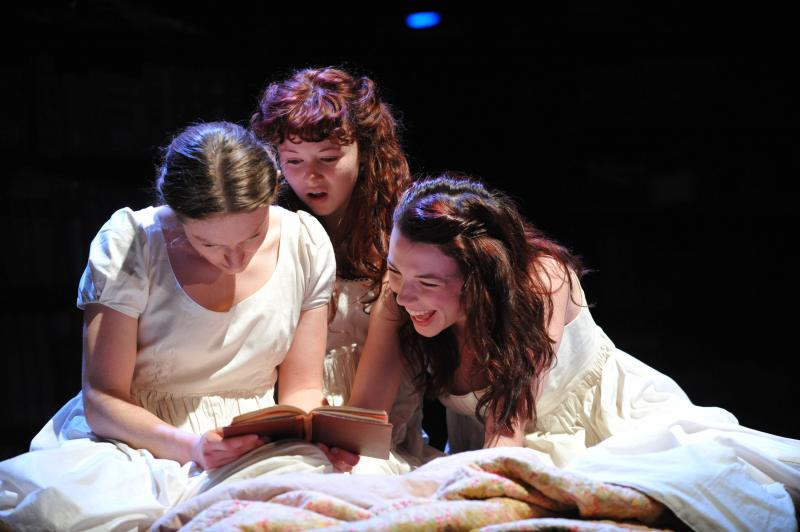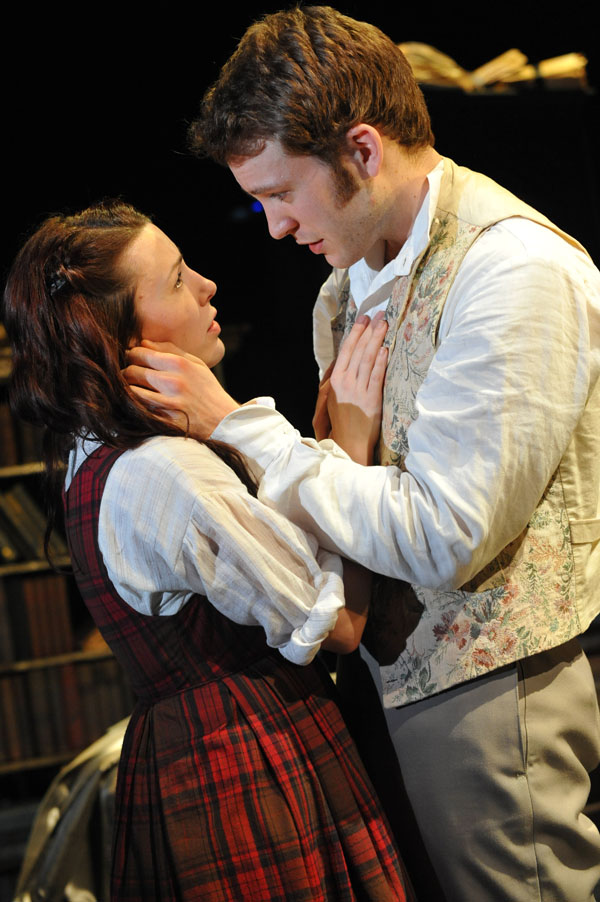Mary Shelley, Tricycle Theatre | reviews, news & interviews
Mary Shelley, Tricycle Theatre
Mary Shelley, Tricycle Theatre
Shared Experience return with a long-winded and unsatisfying docudrama

Mary Shelley and all her works have dogged the footsteps of contemporary theatre — in a way that’s a bit reminiscent of her most famous creation. Last year, there was Frankenstein at the National and this year a revival of Howard Brenton’s Bloody Poetry (about the Shelley/Byron ménage) on the fringe. Now, following the success of their Brontë, Shared Experience theatre company are back in London with a new Mrs Shelley docudrama.
The good news is that Mary’s story is a perpetually interesting one. Born in 1797, she was the daughter of the radical philosopher William Godwin and Mary Wollstonecraft, the feminist. After her mother died when Mary was 11 days old, her father brought her and her half-sister Fanny up by himself. When she was four, Godwin married Mary Jane Clairmont, a neighbour. When she was 16, she eloped with the poet Percy Bysshe Shelley along with Clairmont’s daughter, Jane. Aged 19, she wrote Frankenstein.
It was an attempt to live differently
In that year, 1816, Mary spent a summer in Geneva with Shelley, Lord Byron and her step-sister Jane (aka Claire). It was an attempt to live differently, outside of social and sexual conventions, but this experiment in radical ways of relating to each other had enormous psychological costs. Shelley’s first wife Harriet committed suicide, and so did Fanny. Most of the children the women bore didn’t survive.
This version, written by Helen Edmundson and directed by Polly Teale, looks closely at Mary’s early years. The play begins with the domestic life of the Godwins. As William Godwin struggles to make a living through writing, his wife holds things together, with sporadic help from their teenage daughters, Mary, Jane and Fanny. When the 21-year-old romantic poet Shelley calls on his hero Godwin — who has penned books on radical politics — the young girls all fall in love with him.
 In this hormonal hothouse, it is Mary who is chosen and, against the wishes of her father, the couple elope, taking Jane with them. In the second half, we gallop around Europe with the three youngsters, watch the women as they get pregnant and struggle to survive on little money, and see how Godwin’s family is almost suffocated by debt. Slowly, the fraught conflicts between the family and the runaways are reconciled, although not before things get very messy. This is partly because Edmundson’s text is awkward, plodding and long-winded, and partly because the play attempts to cover too much ground.
In this hormonal hothouse, it is Mary who is chosen and, against the wishes of her father, the couple elope, taking Jane with them. In the second half, we gallop around Europe with the three youngsters, watch the women as they get pregnant and struggle to survive on little money, and see how Godwin’s family is almost suffocated by debt. Slowly, the fraught conflicts between the family and the runaways are reconciled, although not before things get very messy. This is partly because Edmundson’s text is awkward, plodding and long-winded, and partly because the play attempts to cover too much ground.
Still, the characterisation is sound: the strong-minded but impractical Godwin, his talkative and spiky wife, and the contrasting daughters — truth-telling, passionate Mary; anxious, timid Fanny and the highly strung, histrionic Jane. In the best scenes, the passions flow, hearts beat faster, and voices are raised in anger, or anguish. On an evocative set, a claustrophobic room with a long table and bookshelves, you’d expect the play to make connections between Mary’s life and her masterpiece, Frankenstein.
But, oddly enough for a company that specialises in showing the workings of the inner mind, there is very little of that. Although the play opens with a vivid image of Mary’s mother drowning, and there are glimpses of Mary breathing life into a dead baby, that’s about all there is. Is Doctor Frankenstein a cipher for Godwin, or is Dad a monster? Is Shelley a father figure? Who knows? Worse, by the end of this long evening, I no longer cared.
Still, the cast is good. Kristin Atherton is a vivacious and glowing Mary, Flora Nicholson a prim Fanny and Shannon Tarbet a shrill Jane. William Chubb is steady as the high-minded Godwin and Sadie Shimmin is satisfyingly frantic as his wife; only Ben Lamb (pictured above right with Atherton) is disappointingly uncharismatic as Shelley. So despite the elemental atmosphere of the play, with its depiction of the forces of nature, and the inherent interest of the material, the connections between life and art are never convincing enough to repay our investment in the characters.
rating
Buy
Share this article
Add comment
The future of Arts Journalism
You can stop theartsdesk.com closing!
We urgently need financing to survive. Our fundraising drive has thus far raised £49,000 but we need to reach £100,000 or we will be forced to close. Please contribute here: https://gofund.me/c3f6033d
And if you can forward this information to anyone who might assist, we’d be grateful.

Subscribe to theartsdesk.com
Thank you for continuing to read our work on theartsdesk.com. For unlimited access to every article in its entirety, including our archive of more than 15,000 pieces, we're asking for £5 per month or £40 per year. We feel it's a very good deal, and hope you do too.
To take a subscription now simply click here.
And if you're looking for that extra gift for a friend or family member, why not treat them to a theartsdesk.com gift subscription?
more Theatre
 Ragdoll, Jermyn Street Theatre review – compelling and emotionally truthful
Katherine Moar returns with a Patty Hearst-inspired follow up to her debut hit Farm Hall
Ragdoll, Jermyn Street Theatre review – compelling and emotionally truthful
Katherine Moar returns with a Patty Hearst-inspired follow up to her debut hit Farm Hall
 Troilus and Cressida, Globe Theatre review - a 'problem play' with added problems
Raucous and carnivalesque, but also ugly and incomprehensible
Troilus and Cressida, Globe Theatre review - a 'problem play' with added problems
Raucous and carnivalesque, but also ugly and incomprehensible
 Clarkston, Trafalgar Theatre review - two lads on a road to nowhere
Netflix star, Joe Locke, is the selling point of a production that needs one
Clarkston, Trafalgar Theatre review - two lads on a road to nowhere
Netflix star, Joe Locke, is the selling point of a production that needs one
 Ghost Stories, Peacock Theatre review - spirited staging but short on scares
Impressive spectacle saves an ageing show in an unsuitable venue
Ghost Stories, Peacock Theatre review - spirited staging but short on scares
Impressive spectacle saves an ageing show in an unsuitable venue
 Hamlet, National Theatre review - turning tragedy to comedy is no joke
Hiran Abeyeskera’s childlike prince falls flat in a mixed production
Hamlet, National Theatre review - turning tragedy to comedy is no joke
Hiran Abeyeskera’s childlike prince falls flat in a mixed production
 Rohtko, Barbican review - postmodern meditation on fake and authentic art is less than the sum of its parts
Łukasz Twarkowski's production dazzles without illuminating
Rohtko, Barbican review - postmodern meditation on fake and authentic art is less than the sum of its parts
Łukasz Twarkowski's production dazzles without illuminating
 Lee, Park Theatre review - Lee Krasner looks back on her life as an artist
Informative and interesting, the play's format limits its potential
Lee, Park Theatre review - Lee Krasner looks back on her life as an artist
Informative and interesting, the play's format limits its potential
 Measure for Measure, RSC, Stratford review - 'problem play' has no problem with relevance
Shakespeare, in this adaptation, is at his most perceptive
Measure for Measure, RSC, Stratford review - 'problem play' has no problem with relevance
Shakespeare, in this adaptation, is at his most perceptive
 The Importance of Being Earnest, Noël Coward Theatre review - dazzling and delightful queer fest
West End transfer of National Theatre hit stars Stephen Fry and Olly Alexander
The Importance of Being Earnest, Noël Coward Theatre review - dazzling and delightful queer fest
West End transfer of National Theatre hit stars Stephen Fry and Olly Alexander
 Get Down Tonight, Charing Cross Theatre review - glitz and hits from the 70s
If you love the songs of KC and the Sunshine Band, Please Do Go!
Get Down Tonight, Charing Cross Theatre review - glitz and hits from the 70s
If you love the songs of KC and the Sunshine Band, Please Do Go!
 Punch, Apollo Theatre review - powerful play about the strength of redemption
James Graham's play transfixes the audience at every stage
Punch, Apollo Theatre review - powerful play about the strength of redemption
James Graham's play transfixes the audience at every stage
 The Billionaire Inside Your Head, Hampstead Theatre review - a map of a man with OCD
Will Lord's promising debut burdens a fine cast with too much dialogue
The Billionaire Inside Your Head, Hampstead Theatre review - a map of a man with OCD
Will Lord's promising debut burdens a fine cast with too much dialogue

Comments
The reviewer asks thinks